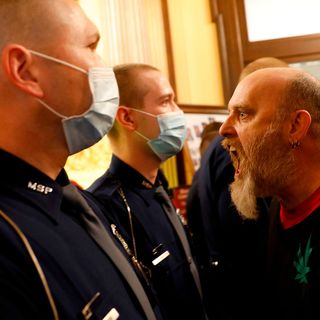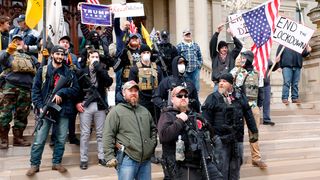On April 17, President Donald Trump issued a series of calls on Twitter to "LIBERATE" Michigan, Minnesota and Virginia.
Within three days the number of protests in the country had doubled and nearly 100,000 more Americans had tested positive for coronavirus.
New research from the United States Studies Centre using the Global Database of Emotion, Language and Tone, shows that despite the United States having one of the fastest rates of infection in the world in April, the number of in-person anti-government (federal, state and local) protests in the country surged to a level higher than that reached during 2019, the so-called Year of Global Protest.
Figure 1. The number of nation-wide protests in mid-April 2020 eclipsed all 2019 protest movements: GDELT data showing the five-day rolling average of national protests between 1 Jan 2019 and 4 May 2020
The vast majority of the increase in protests in March to April were in opposition to state-enforced lockdowns and stay-at-home orders. While the protests surged after President Trump's interventions, it's clear that he did not cause the anti-lockdown movement himself. Protests in the United States were already rising rapidly when he weighed in.
Figure 2. Increase in national protests following LIBERATE tweets: GDELT data for the number of national protests between 1 April and 12 May 2020
They're not spread evenly across the country
Protests targeted at political enemies has been a common trend not just from Trump's administration, but more generally in his public life. The birther conspiracy theory, Obamagate and even the debunked Joe Scarborough murder conspiracy theory all bear the hallmarks of this ability to identify grievances involving his political enemies, and to amplify them.
In a limited sense, it's worked too. When broken down by which states endured the largest per cent increase in protests between March and April, there is a clear trend of states that are conservative or at least moderate who have Democratic governors (responsible for implementing lockdowns).
Table 1. Per cent increase in state protests between March and April 2020
|
Rank |
State |
Increase in protests March-April 2020 (%) |
Governor and party affiliation |
Electoral college 2016 and margin |
COVID-19 cases(as at 30 April)[^22] |
Partial reopening plan announced |
|
1 |
Kentucky |
115.0 |
Andy Beshear (Democrat) |
Trump (29.8%) |
4,375 |
29 April |
|
2 |
Wisconsin |
97.0 |
Tony Evers (Democrat) |
Trump (0.7%) |
6,520 |
11 May |
|
3 |
Colorado |
73.0 |
Jared Polis (Democrat) |
Clinton (4.9%) |
14,735 |
22 April |
|
4 |
Maryland |
21.3 |
Larry Hogan (Republican) |
Clinton (26.4%) |
20,849 |
14 May |
|
5 |
Michigan |
15.2 |
Gretchen Whitmer (Democrat) |
Trump (0.3%) |
40,399 |
6 May |
|
6 |
Washington state |
13.0 |
Jay Inslee (Democrat) |
Clinton (15.7%) |
13,842 |
30 April |
|
7 |
Louisianan |
11.9 |
John Bel Edwards (Democrat) |
Trump (19.7%) |
27,660 |
11 May |
|
8 |
Virginia |
10.9 |
Ralph Northam (Democrat) |
Clinton (5.4%) |
14,961 |
11 May |
|
9 |
Georgia |
10.8 |
Brian Kemp (Republican) |
Trump (5.1%) |
25,572 |
20 April |
|
10 |
Ohio |
10.2 |
Mike DeWine (Republican) |
Trump (8.1%) |
17,303 |
27 April |
On different occasions, President Trump has clashed with each of the governors listed below. Many of the states they run were crucial in the 2016 election and look set to be crucial again in 2020.
Fewer protesters, more danger
It must be said that although the number of individual protests has been high, the number of protesters has not been.
Preliminary data from the Crowd Counting Consortium seems to indicate that these protests have been significantly smaller in scale than many of those that took place throughout 2019. For example, there were an estimated 313,000 protesters in July 2019, compared to a preliminary estimate of 43,000 throughout April 2020, including repeat protesters.
Many individual protests during 2019 eclipsed this number many times over. Indeed, the wave of Tea Party protests a decade earlier on April 15, 2009, mobilised more than 300,000 people in more than 500 distinct protests across the United States.
But none of these actions occurred during a pandemic like COVID-19.
Coronavirus and protest: How COVID-19 has changed the face of American activism

Protesting at this time is a dangerous political act. After 1,500 people attended a rally in Madison, Wisconsin, in late April more than 70 people tested positive for the virus who indicated to health officials that they had "attended a large event".
As the larger of these actions have centred on state capitols, anonymous cell phone data has shown that protesters have often travelled hundreds of miles and even across state lines to attend, before returning home.
For some of these protesters, home can be more rural parts of the United States which often lack the necessary health infrastructure to deal with any outbreak, let alone one as aggressive as the novel coronavirus.
The increase in the number of individual protest events, however small the gatherings and especially considering the health risks, is significant.
It's hard to imagine any other American president in recent memory seeing an uptick in civil resistance that involved the flouting of public health directives and deciding to lean into it, rather than to moving to quell it.
The left has been mobilising, too
All the while, progressive activists in the country have been aggressively digitally mobilising while adhering to social distancing measures.
The unequal impact of the COVID-19 pandemic has laid bare and activated structural problems in American society.
An historic surge in unemployment caused by a pandemic in a nation where healthcare is contingent on employment for most will likely send the progressive pushes for Medicare For All and green economic reform into hyperdrive.
As such, while Washington weighs the best options to pull itself out of this crisis, the positions of several progressive groups, particularly those with a focus on healthcare, equal access to voting and economic equality, are getting more mainstream airplay through political champions in Congress than ever.
For them, the very presence of protesters on the street at a time like this is outrageous, let alone the president's support for the protesters.
The implications of such activation on either side of the political spectrum could have grave consequences for the already fractured state of the American union beset by a virus and hurtling towards a high-stakes presidential election in November.






